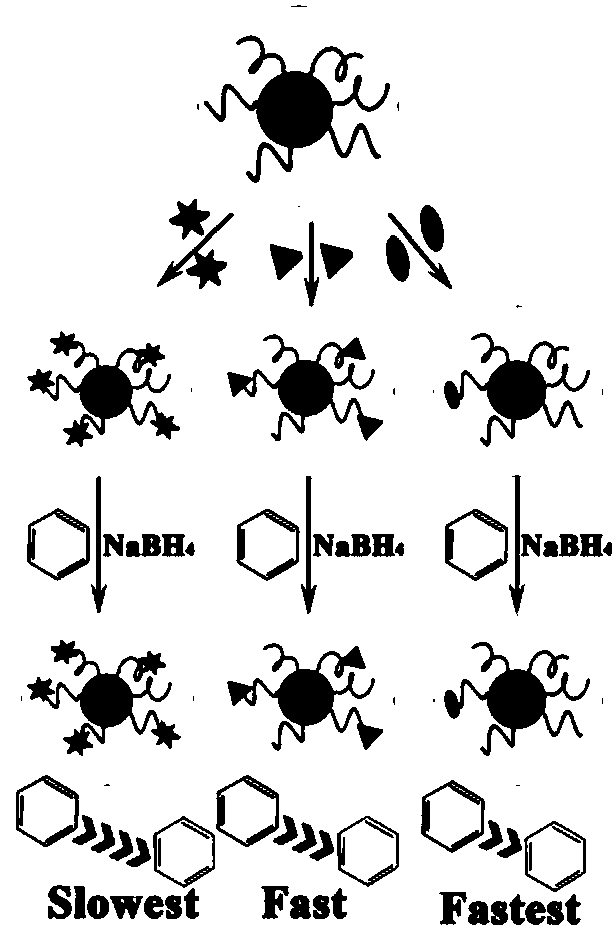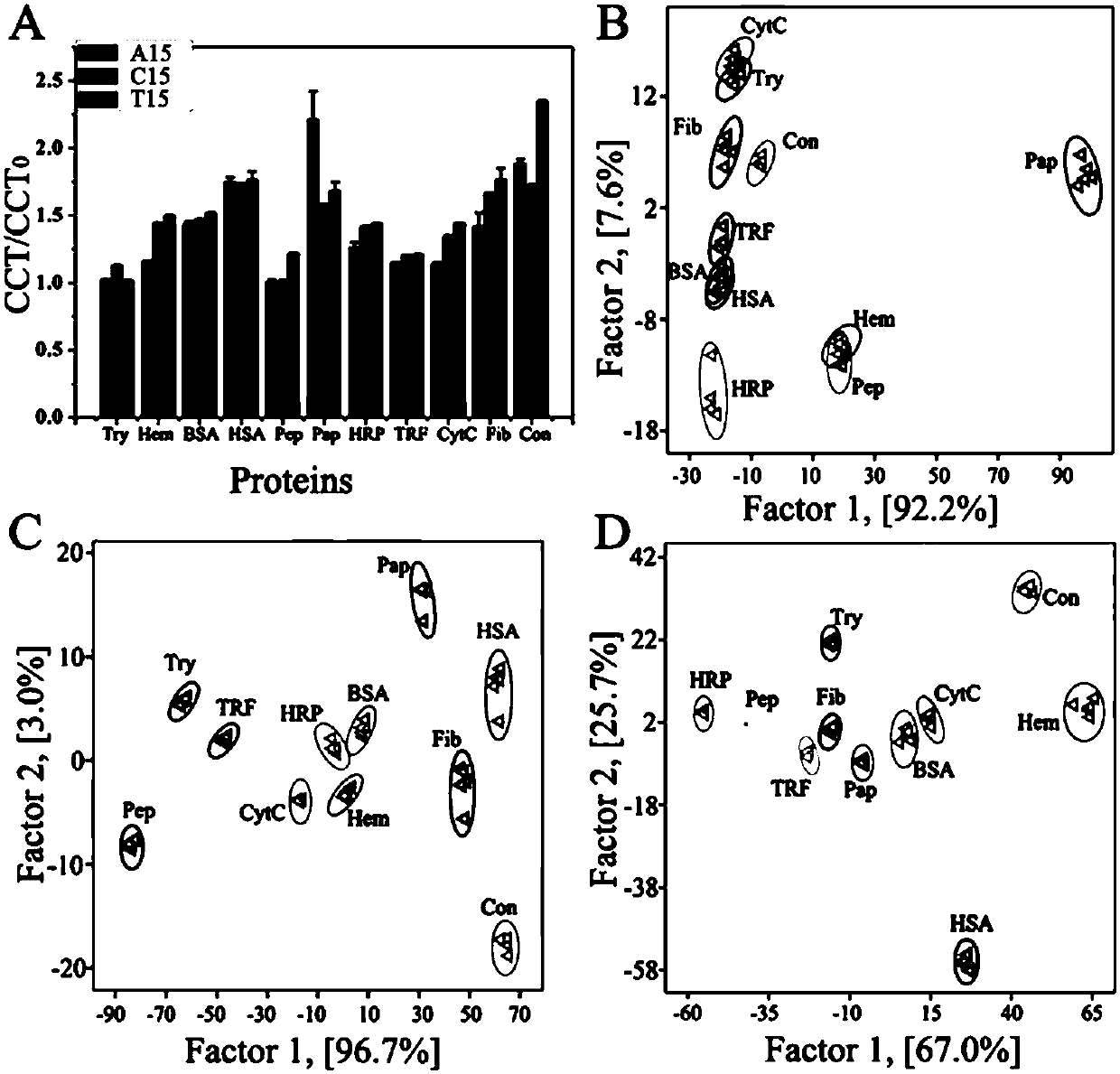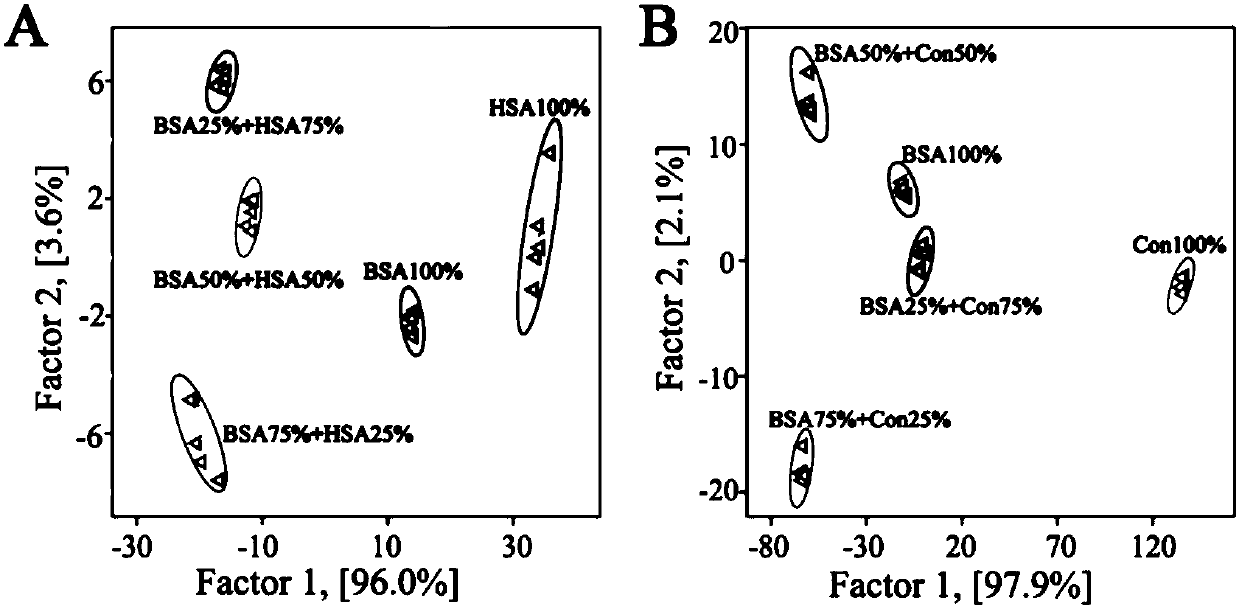A method for protein detection based on nano-gold-dna composites
A composite material and nano-gold technology, applied in the field of protein detection, can solve the problems of complex operation, heavy workload, and difficulty in realizing high-throughput rapid detection of proteins, and achieve the effect of cumbersome preparation process
- Summary
- Abstract
- Description
- Claims
- Application Information
AI Technical Summary
Problems solved by technology
Method used
Image
Examples
Embodiment 1
[0035] Example 1 Method for detecting protein based on nano-gold-DNA composite material
[0036] The method for detecting protein based on nano-gold-DNA composite material provided in this embodiment includes the following steps:
[0037] 1. Preparation of gold nanoparticles: prepared by reducing chloroauric acid with sodium citrate, the concentration of chloroauric acid solution is 50mM, the molar ratio of chloroauric acid and sodium citrate is 3.5:1, and the average gold nanoparticles in the resulting solution The particle size is about 13nm;
[0038] 2. Preparation of gold nano-DNA complex: add 10 μL of a DNA solution with a concentration of 1 μM at one end modified with sulfhydryl group to 50 μL of the above solution containing gold nanoparticles. The DNA is poly(A) 15 , Get nano gold-poly(A) 15 Complex;
[0039] 3. Add 50μL of each of the 11 protein solutions with a concentration of 300nM (100nM or 500nM) to 60μL of the above solution containing the gold nano-DNA complex, and inc...
Embodiment 2
[0049] Example 2 Detection of protein mixtures of different components based on nano-gold-DNA composite materials
[0050] It includes the following steps:
[0051] 1. Preparation of gold nanoparticles: prepared by reducing chloroauric acid with sodium citrate, the concentration of chloroauric acid solution is 50mM, the molar ratio of chloroauric acid and sodium citrate is 3.5:1, and the average gold nanoparticles in the resulting solution The particle size is about 13;
[0052] 2. Preparation of gold nano-DNA complex: add 10 μL of a DNA solution with a concentration of 1 μM at one end modified with sulfhydryl group to 50 μL of the above solution containing gold nanoparticles. The DNA is poly(A) 15 , Get nano gold-poly(A) 15 Complex;
[0053] 3. Add 50 μL each of the two protein mixed solutions (BSA and HSA mixed solution or BSA and Con mixed solution) with a concentration of 300 nM to 60 μL of the above solution containing the gold nano-DNA complex, and incubate each at 37°C for 30 m...
Embodiment 3
[0063] Example 3 Identifying proteins in serum samples based on nano-gold-DNA composite materials
[0064] It includes the following steps:
[0065] 1. Preparation of gold nanoparticles: prepared by reducing chloroauric acid with sodium citrate, the concentration of chloroauric acid solution is 50mM, the molar ratio of chloroauric acid and sodium citrate is 3.5:1, and the average gold nanoparticles in the resulting solution The particle size is about 13;
[0066] 2. Preparation of gold nano-DNA complex: add 10 μL of a DNA solution with a concentration of 1 μM at one end modified with sulfhydryl group to 50 μL of the above solution containing gold nanoparticles. The DNA is poly(A) 15 , Get nano gold-poly(A) 15 Complex;
[0067] 3. Add 50μL of each of the 11 protein solutions with a concentration of 3μM to 60μL of the above solution containing gold nano-DNA complex, and incubate at 37°C for 30min; do at least 5 replicates for each protein; 2 O is a blank control, that is, add ddH to 60 ...
PUM
| Property | Measurement | Unit |
|---|---|---|
| particle size | aaaaa | aaaaa |
| particle diameter | aaaaa | aaaaa |
| particle size | aaaaa | aaaaa |
Abstract
Description
Claims
Application Information
 Login to View More
Login to View More - R&D
- Intellectual Property
- Life Sciences
- Materials
- Tech Scout
- Unparalleled Data Quality
- Higher Quality Content
- 60% Fewer Hallucinations
Browse by: Latest US Patents, China's latest patents, Technical Efficacy Thesaurus, Application Domain, Technology Topic, Popular Technical Reports.
© 2025 PatSnap. All rights reserved.Legal|Privacy policy|Modern Slavery Act Transparency Statement|Sitemap|About US| Contact US: help@patsnap.com



